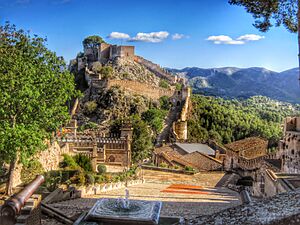Xativa Castle facts for kids
The Xativa Castle (called Castillo de Játiva in Spanish and Castell de Xàtiva in Valencian) is an amazing castle in the city of Xàtiva, close to Valencia, Spain. It's actually two castles in one! There's the older "Castillo Menor" (Smaller Castle) and the newer "Castillo Mayor" (Main Castle). The older one was built on ancient Iberian and Roman ruins. The main castle was built later, during the Middle Ages. This impressive fortress sits high up, about 310 meters (1,017 feet) above the modern city.
Contents
Why Xativa Castle Was Important
The Xativa Castle was built in a very smart spot. It was right on the ancient road called Via Augusta. This road was super important! It stretched all the way from Rome, over the Pyrenees mountains, and down the Mediterranean coast. It went to cities like Cartagena and Cádiz. Because of its location, the castle was a key place for controlling travel and trade.
Early History of the Castle
The "Castillo Menor" (Smaller Castle) has a very long history. It started as a strong fort for the Celtiberians, an ancient group of people. Later, in the 200s BC, the Carthaginians took control of it. People say that the famous general Hannibal planned his attack on the Roman city of Saguntum right here. It's also believed that Hannibal's son was born at Xativa Castle in 218 BC. After that, the Roman general Scipio conquered the castle.
Xativa Castle in the Middle Ages
During the medieval period, the castle saw a lot of action. In 1092, the Almoravid dynasty took over the fortress. But they didn't stay long! There was a big uprising in 1145, and they were pushed out. During this time, the ruler of Valencia, Marwan Abd-al-Aziz, attacked the castle. By 1171, the castle and the rest of the coast joined the lands controlled by the Almohads.
The Christian Conquest
King James I of Aragon began his Christian conquest in the area in the summer of 1239. He captured Xàtiva on May 22, 1244. This happened after a long five-month siege! To avoid more fighting, the governor of the castle signed the Treaty of Xàtiva. He gave the smaller castle to King James I. The Muslim people were allowed to stay in the larger castle for two more years, as agreed in the treaty.
After two years, King James I of Aragon brought many new settlers from Catalonia and Aragon to Xàtiva. Sadly, many Muslim and Jewish people were forced to leave the city. In the years that followed, many Mudéjar (Muslims living under Christian rule after the Reconquista) moved to Granada or North Africa.
Later Battles and Damage
The Xativa Castle was involved in more fighting during the War of the Spanish Succession. In 1707, during the siege of Xàtiva, soldiers from Castile and France defeated troops from Aragon and England who had hidden in the fortress. Later, in 1748, a big earthquake hit the region. It caused serious damage to the castle. After this, the castle was no longer as important for military strategy.
See also
 In Spanish: Castillo y conjunto monumental de Játiva para niños
In Spanish: Castillo y conjunto monumental de Játiva para niños



